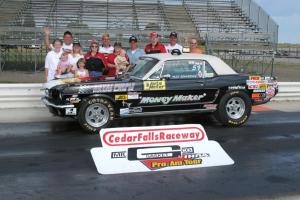quote:
Originally posted by Built351c:
I have never changed out jets or anything on my carb. Could someone give a list of do's and dont's for adjusting for weather conditions and for different track elevations. Example.Hot weather you do this ......
Humid weather Ect.....
Cool weather ....
you get the point. The reasons I ask is when the weather was hot and humid the car ran like sh*t and I lost almost a half of second. When it was cool out the car picked up. 13.2 @ 107 to 12.5 @ 111. Thanks for the help.
1st thing, I'd recommend you do is some study work on how a carb works, why it works and where & how you can modify it. It typically is easier to know how & why to modify something if you know how it works in the first place. Start out by reading EVERYTHING at:
http://www.holley.com/HiOctn/TechServ/TechInfo/FMCTech.html
As you probably will quickly realize, every combination of engine parts (carb, cam, intake, rpm operation range, etc.) will perform differently under various conditions including air temps, humidity levels & barometric pressure levels; so there aren't any hardened rules to determine optimum, universal carb tuning. The majority of the tuning will involve jet selection, power valve (PV) selection and discharge nozzle (squirter or shooter) selection.
And yes, many folks buy & use various tuning devices and/or "weather stations" to assist them in determining when to make carb adjustment changes. BUT - when you first start out, you usually don't HAVE a weather station. But I know you can at least locate a dime-store thermometer; take it to the track and place it in the shade in your pit spot to give you air tempertures.
Now, given your current engine combo, and armed with your trusty thermometer, start to build a Performance Log - such as a spiral notebook - begin to record the info off your time slips, what the air temperature was and what tune was in your carb (what size jets, PVs & shooters) when you made the pass.
Now let's say you've established your carb's baseline performance at 65 degrees... From your baseline you'll likely see as the air temps changes (up or down) 5 to 10 degrees from the normal baseline that the performance will change markedly. You mentioned that your performance was not good when it was hot & humid and it was better when the air was cooler. This likely indicates that that while it was hot & humid you were jetted way fat (also called too rich, too much jet) so when the air cooled down, the tune came back to your car; closer to optimum.
GUIDELINE: The basic "jet rule-of-thumb" is you'll need to INCREASE your jet size one size larger for every 5 degrees that the air cools off to maintain your performance level. Two jet sizes for 10 degrees of change. Likewise, as the temps go up from your baseline of 65, you need to DECREASE your jet size in a similar stepped fashion, larger jet size as the air cools below 75 degrees. As mentioned earlier, changes in relative humidity (RH%) and barometric pressure levels will also effect your carb tuning, but air temps are your biggest factor. This rule will give you a starting point to establish your own performance curves with your engine combination.
I CANNOT EMPHASIS ENOUGH, "your results may vary"....so, TEST & RECORD, TEST & RECORD, TEST & RECORD your performance & level of tune!
Also: As you've read here; only make one change at a time. If you change your jets AND your tire pressure - you won't know which change made the difference in performance. So make 1 change then 3 passes and determine if change was good or bad. Then make the next change....
Good Luck!
Ryan 







 Mustangsandmore Forums
Mustangsandmore Forums

 Ford Racing
Ford Racing

 adjusting the carb for weather and track - Advice please.
adjusting the carb for weather and track - Advice please.


